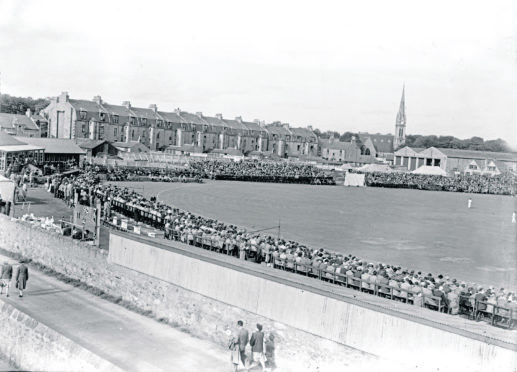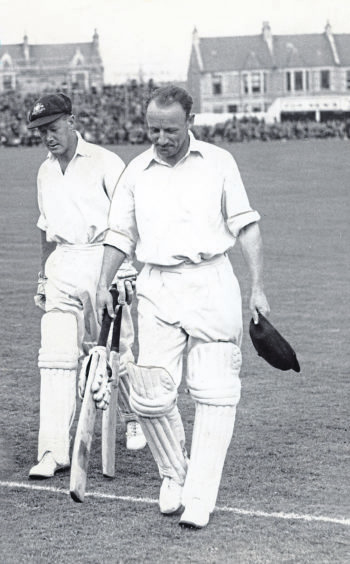He’s 87 now and, in some cricket circles, that number is considered unlucky: it’s 13 short of a hundred.
Yet, there was nothing downbeat about William “Buff” Hardie when he talked this week about being one of the 18,000 spectators who watched the late, great Sir Don Bradman and his Australian “Invincibles” parade their talents at Aberdeenshire’s Mannofield 70 summers ago.
Hardie, of course, has gained plenty of laurels of his own throughout his multi-faceted life – including being a member of the popular Scotland The What trio alongside George Donald and Steve Roberson, who performed all across the world. They were awarded MBEs in 1994 and honoured with the Freedom of Aberdeen in 2008.
But as one of life’s genuine cricket Buffs, Mr Hardie he has never forgotten the remarkable scenes which surrounded the biggest match in the history of north-east cricket in the Granite City in 1948 – a two-day contest between Bradman and his illustrious compatriots and the amateurs of Scotland.
Hardie said: “The place was packed and I don’t suppose we’ll ever see anything like it again. The organisers had erected temporary stands around the ground and every space was six, seven, eight rows deep with supporters.
“I was just 17, but we had all followed the Australians throughout that summer. It wasn’t just Bradman. They had other wonderful players, of the quality of Keith Miller – one of the best allrounders in history – Neil Harvey, Ray Lindwall, Ian Johnsonand so it went on.
“They reckon there were 8,000 there on the first day when the Scots were bowled out for 178. But our lads fought hard and the Australians didn’t have it all their own way.
“Or not on the first day at least.
“However, it was all managed quite nicely for the Saturday when 10,000 people turned up to watch the action. Bradman came to the crease quite quickly and made a near effortless 123 not out in about 90 minutes.
“He was 40 years old by that stage but we all admired his talent and that of Colin McCool, who also hit a century.
“Eventually, they declared (on an imposing 407 for six) and there wasn’t much the Scots could do to stem the tide. Even the Australian wicketkeeper Don Tallon took his gloves off, had a wee bowl and took a couple of wickets as Scotland were dismissed for 142.
“But the result didn’t matter to anyone who was lucky enough to be there. It was Bradman’s final appearance on British soil and we had been there to see it.
“The next day, he travelled to Balmoral to meet the King (George VI) and some of the stuffier royal commentators were shocked when he was photographed walking with the monarch with his hands in his pockets. But it obviously didn’t bother the King that much – after all, Bradman was given his knighthood just a few weeks later.”
Even now, Hardie can still recall the sheer excitement which enveloped the city, with buses speeding along from Union Street to the ground and the whole place full of people with beaming smiles on their faces.
He and his now sadly departed STW confreres made millions laugh in their own right, while promoting the Doric language and creating rib-tickling tales often set in the fictional Aberdeenshire Village of Auchterturra.
But he was someone who has never lost the cricket bug since that early introduction to the game’s legends. Indeed, as he added, he was also at some of the most astonishing tussles in the chronicles of the Test game.
As he explained: “I didn’t get to as many Tests as I would have liked but I was at Old Trafford in 1956 when Jim Laker took 19 wickets to hasten an Australian defeat in Manchester. That was something remarkable.
“Then later on, I went to York for a holiday with my wife, Margaret, and we heard England were in all kinds of trouble. When we eventually returned to our hotel, I asked one of the staff: ‘So, has the match finished?’
“He replied: “Not at all. Ian Botham went crazy in the second innings and he has given his team a narrow lead.’
“Well, I had to be there for the final day at Headingley (in 1981) and it obviously became one of the greatest fightbacks, with Bob Willis ripping through the Australians as England achieved an incredible win.
“I know I’ve been fortunate. These are matches which people will talk about as long as cricket is played.”
Hardie has never strayed far from his roots. He celebrated his 80th birthday in 2011 with a group of friends at Mannofield and the setting was, where else, the Bradman Suite.
He said: “I told the guests it was nice I had reached 80 at the same venue where I had watched the Don pass the same score more than 60 years earlier. And it really struck a chord.”
It does not seem so far from Australia to Auchterturra, does it?

